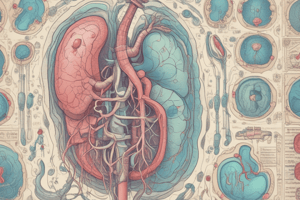Podcast
Questions and Answers
What is the primary characteristic of autosomal dominant polycystic kidney disease (ADPKD)?
What is the primary characteristic of autosomal dominant polycystic kidney disease (ADPKD)?
- Development of primary tumors in the kidneys
- Absence of nephrons in the kidneys
- Formation of multiple cysts in both kidneys (correct)
- Formation of single cysts in one kidney
Which gene mutation is more commonly associated with ADPKD?
Which gene mutation is more commonly associated with ADPKD?
- PKD3 gene mutation
- PKD4 gene mutation
- PKD2 gene mutation
- PKD1 gene mutation (correct)
In most families with a diagnosis of ADPKD, what percentage of cases shows that one of the parents also has the diagnosis?
In most families with a diagnosis of ADPKD, what percentage of cases shows that one of the parents also has the diagnosis?
- 50%
- 95% (correct)
- 10%
- 75%
What percentage of cases in families with ADPKD can mutations be found as 'de novo'?
What percentage of cases in families with ADPKD can mutations be found as 'de novo'?
Where in the kidneys are cysts formed in individuals with ADPKD?
Where in the kidneys are cysts formed in individuals with ADPKD?
What is a common characteristic of the cysts formed in autosomal dominant polycystic kidney disease (ADPKD)?
What is a common characteristic of the cysts formed in autosomal dominant polycystic kidney disease (ADPKD)?
What genetic mutation is primarily associated with the development of ADPKD?
What genetic mutation is primarily associated with the development of ADPKD?
In families affected by ADPKD, what is the likelihood that a diagnosed patient's parent also has the condition?
In families affected by ADPKD, what is the likelihood that a diagnosed patient's parent also has the condition?
What proportion of ADPKD cases is characterized by 'de novo' mutations?
What proportion of ADPKD cases is characterized by 'de novo' mutations?
What is a key feature of cyst development in individuals with ADPKD, despite the presence of the mutant gene?
What is a key feature of cyst development in individuals with ADPKD, despite the presence of the mutant gene?
Flashcards
ADPKD
ADPKD
Autosomal dominant polycystic kidney disease, causing multiple cysts in the kidneys (and sometimes other organs).
PKD1 gene
PKD1 gene
A gene involved in ADPKD, mutation is more frequent than PKD2 mutation.
PKD2 gene
PKD2 gene
Another gene involved in ADPKD, mutation is less common than PKD1.
ADPKD inheritance
ADPKD inheritance
Signup and view all the flashcards
De novo mutations
De novo mutations
Signup and view all the flashcards
What makes ADPKD an autosomal dominant disorder?
What makes ADPKD an autosomal dominant disorder?
Signup and view all the flashcards
What is ADPKD characterized by?
What is ADPKD characterized by?
Signup and view all the flashcards
Which gene is most commonly mutated in ADPKD?
Which gene is most commonly mutated in ADPKD?
Signup and view all the flashcards
What are 'de novo' mutations?
What are 'de novo' mutations?
Signup and view all the flashcards
Where are the cysts formed in ADPKD?
Where are the cysts formed in ADPKD?
Signup and view all the flashcards
Study Notes
Hereditary Kidney Diseases
- Includes autosomal dominant polycystic kidney disease (ADPKD), Alport syndrome, Fanconi syndrome, and congenital kidney anomalies.
Autosomal Dominant Polycystic Kidney Disease (ADPKD)
- Characterized by the formation of multiple cysts in both kidneys (bilateral), and sometimes other organs (liver, pancreas).
- The PKD1 gene mutation (16 chromosomes) is more common (85-90%) than the PKD2 gene mutation (4 chromosomes).
- In some families, neither PKD1 nor PKD2 mutations are found (PKD3?).
- In most cases (95%), one parent of those diagnosed with ADPKD also has the diagnosis.
- A "second hit" theory suggests an additional mutation within certain tubule parts affecting nephrons is required for cyst formation.
Alport Syndrome
- Named for Dr. Cecil Alport.
- A type of hereditary nephritis.
- Caused by mutations in the gene controlling collagen type 4.
- Includes sensorineural hearing loss and visual disturbances.
- Inheritance modes include X-linked dominant (80%), autosomal recessive (15%), and autosomal dominant (5%).
- Prevalence: 1:10,000 to 1:50,000.
Fanconi Syndrome
- A rare disorder of kidney tubule function.
- Characterized by the excretion of excess glucose, bicarbonate, phosphates, uric acid, potassium.
- Diagnosis: Confirmed by high glucose levels, phosphates, and amino acids in the urine (despite normal blood glucose levels).
- Can be genetic or caused by heavy metal exposure, certain medications, vitamin D deficiency, kidney transplant, multiple myeloma, or amyloidosis.
- Symptoms in infants include excessive drinking and urination, stunting, growth retardation, chronic kidney disease, and/or kidney transplant in childhood.
- Adult symptoms include weakness and bone pain.
Congenital Kidney Anomalies
- Include various abnormalities including Duplication and Splicing Abnormalities, Horseshoe Kidney, Ectopic Kidney, Malrotation, and Multicystic Renal Dysplasia, and Renal Agenesis.
- Some abnormalities are detected during prenatal ultrasounds or planned examinations; Others may be asymptomatic.
- Treatment options can include surgery.
Other Information
- ADPKD is the third most common hereditary disease after hypercholesterolemia and otosclerosis. Prevalence: 1:400 to 1:1000. Highest incidence between 30-50 years old.
- Alport syndrome disease course is milder in women and more severe, rapid, and progressive in men.
- Treatment for Fanconi syndrome usually involves managing symptoms via sodium bicarbonate, potassium, phosphate, and vitamin D supplements.
Studying That Suits You
Use AI to generate personalized quizzes and flashcards to suit your learning preferences.




